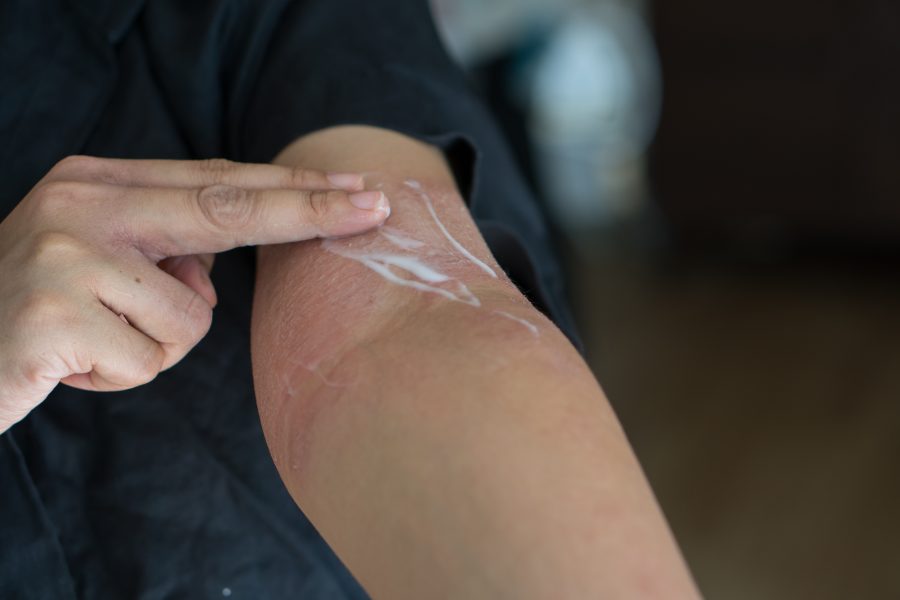California dermatologist pioneers a simple, non-prescription treatment for atopic dermatitis | National Eczema Association
While not a cure, Orliderm™ has brought relief to hundreds of children and adults with moderate to severe atopic dermatitis.

Orliderm™ began with an idea.
Ten years ago, Dale Pearlman, MD, a dermatologist who practices in Menlo Park, California, happened to see a TED Talk by a postdoctoral fellow at Princeton University who presented her research on a phenomenon called biofilm.
A slimy matrix of cells and sugars that stick to surfaces, biofilm is produced by many species of bacteria. It's is a "safe haven" that shields bacteria from attack, whether by the immune system or by antibiotics.
Pearlman started to read everything he could get his hands on about biofilm, and eventually, he developed a hypothesis. People with AD have more of a type of harmful bacteria on their skin called Staphylococcus aureus or "staph." And when not kept in check, staph can cause serious infections. That much is obvious, he said.
But if these microbial offenders are foiling our efforts to eliminate them by hiding in slime, they'll never fully disappear, even when treated with the strongest antibiotics. To take them out permanently, he reasoned, you'd need a treatment capable of dissolving the biofilm where bacteria are hiding in plain sight.
Dr. Dale Pearlman decides to put his theory to the test
On the clinical faculty of Stanford University for 25 years, Pearlman was drawn to pediatric dermatology early on. "I've seen lots of kids with eczema over the years, and I had a strong desire to help them," he said.
"I understood the incredible weight of the condition on children and families. No one sleeps. Kids with eczema are constantly itchy and stressed, while their siblings who don't have it may feel neglected by their parents. It's a disease that distorts the family unit."
Determined to make a difference, he started to explore a new approach. He decided to try combining hand sanitizer with a thick steroid ointment. Ethanol—also known as ethyl alcohol—is the ingredient in hand sanitizer responsible for killing bacteria, and the steroid ointment works quickly to cool inflammation. It also prevents the ethanol from stinging.
At first, Pearlman used prescription-strength topical steroid in his formulation but quickly discovered that only a little bit of it was needed to knock out the inflammation.
More fine-tuning led him to experiment with cortisone cream vs. ointment, and ointment won that contest hands down. "The ethanol-cortisone combination only works in the form of an ointment," he explained.
"In ointment, the combined ingredients form hundreds of tiny bubbles – and these bubbles need to be there for the treatment to work. If you mix the ethanol with cream instead of ointment, the bubbles will disappear within 90 minutes after applied to the skin, which isn't long enough for them to penetrate. But in cortisone ointment, the bubbles will stay put long enough to destroy the bacterial biofilm on eczema skin."

Dr. Dale Pearlman
In 2018, Pearlman completed a small, controlled pediatric clinical trial comparing the efficacy of his combination ointment, containing 1% hydrocortisone ointment plus ethanol gel, to 1% hydrocortisone ointment alone.
In one week, the children treated just with hydrocortisone ointment showed a 41% improvement in their SCORAD scores, while those who received Pearlman's combination ointment improved by an average of 74 %.
(SCORAD stands for scoring atopic dermatitis. It is the main tool physicians and researchers use to measure the severity of AD.)
Pearlman's peer-reviewed study was published in the National Society for Cutaneous Medicine's professional journal in January 2019. He is currently seeking support for larger trials that could provide the necessary evidence to confirm his hypothesis and take Orliderm to the next level.
An inexpensive topical with widely available ingredients
"Orliderm seemed almost too simple to be true," said **Carol Roberts, whose 2-year-old son **Joey has severe eczema, "but it has turned out to be a godsend." In May, Roberts found her way to Pearlman, who gave her several jars of Orliderm, and the product relieved her son's symptoms in just one day.

Joey's hand before Orliderm treatment
"Nothing ever worked before," she said, listing all the prescription and over-the-counter (OTC) medications she had used on Joey's skin since his eczema erupted at just 3 months old, from thick moisturizers to topical steroids and moving along to prescription steroids.
She also tried to deal with her toddler's allergies to milk, fish, eggs and nuts in an effort to tame his eczema. Avoiding food triggers proved worthwhile as a way to stave off allergic reactions, but her son's eczema wouldn't budge.
Now that Joey is doing well with Orliderm, Roberts no longer needs to defend herself against well-meaning but baseless accusations that she is somehow responsible for her son's condition.

Joey's hand after 1 week of Orliderm
"Complete strangers would come up to us and ask, 'What happened? Did he fall down?' That hasn't happened for weeks. I'm incredibly grateful to Dr. Pearlman for changing our lives so much for the better."
Orliderm is only one step in a three-part treatment plan
Pearlman goes the extra mile to make his treatment available to parents who tend to be afraid of prescription steroids, immunosuppressants and other strong medications. "They're also busy," he said, "and they're looking for something that's easy to use."
Orliderm fits that bill, he explained. Parents can even learn to mix it themselves by following the instructions on the Orliderm website.
However, the ointment alone isn't enough. On the product's website, Pearlman spells out a three-part treatment, insisting that parents as well as teenage and adult patients follow it to a tee:
- Use Orliderm as specified on the website.
Pearlman provides clear instructions for buying his product's ingredients and mixing them appropriately, along with a link to Amazon.com that offers a complete Orliderm "package," including hand sanitizer, 1% hydrocortisone ointment, mixing sticks and specimen cups.
Dosage is also critically important. Orliderm needs to be applied three times in a row to work properly. Per Pearlman's instructions, rub it in until it penetrates the skin and disappears. Then, repeat. And do it again a third time, after which it will look greasy, and wipe off the excess. Follow this procedure twice a day.
- Bathe the right way. For Pearlman, that means using plain water and keeping soap to a minimum. The water-only approach will help to prevent the irritating and drying effects of soap while preserving the oils in the skin. Of course, soap can be used when necessary—just not all over the body or on inflamed skin.
- Dress the right way. Avoid wearing too many layers of clothing. That will prevent the body from overheating. This arm of Pearlman's treatment is especially important for children, whose ability to regulate their own body temperature is not fully developed. Increased body heat means increased blood flow to the skin, which aggravates eczema.
For the treatment to be effective, Pearlman emphasized, parents should make sure not to skip any aspect of the program. "If it [doesn't work], it will be because a parent substituted cream for ointment," he said, "or because of over-bathing their child with soap.
"Overdressing is the third no-no," he continued. "Whatever you're wearing, dress your child with one fewer layer."
Remember, Orliderm is a treatment – not a cure
Pearlman is the first to insist that Orliderm is not a cure for eczema. In his experience, most children eventually outgrow the condition's worst symptoms, but in the meantime, it typically comes and goes unpredictably. No matter which treatment you use, he said, when you stop using it, eczema's maddening rash and itch will inevitably return.
That's a good argument for giving Orliderm a try, Pearlman added. It's safe and inexpensive, plus it appears to ease the symptoms of eczema that keep families up at night. Joey's parents couldn't agree more. "Sometimes, the simplest treatment turns out to be the best one of all," Roberts said.
** Names have been changed at the request of the interviewee.
Skin Care Physicians of Costa Rica
Clinica Victoria en San Pedro: 4000-1054
Momentum Escazu: 2101-9574
Please excuse the shortness of this message, as it has been sent from
a mobile device.






The Advent of a Novel, Topical Acne Therapy Based on Sebocyte Inhibition, Clascoterone
Of the primary pathogenic factors in acne, namely follicular hyperkeratinization, inflammation, Cutibacterium acnes proliferation, and sebum hyperexcretion, topical therapies are available for all except the latter. This paper describes the in vitro effect of an androgen receptor antagonist, clascoterone, in inhibiting testosterone-stimulated production of pro-inflammatory mediators and lipids from human sebocytes.
Although the mechanism of action of drugs in dermatology is important, of primary relevance to patients and clinicians is the question—can it work and if so, how well? The recent history of topical acne drug development has been punctuated by excitement and innovation but fraught with challenges and failure in pivotal trials (eg, olumacostat glasaretil). This has not been the case for clascoterone. Can it work? Two phase III randomized controlled trials of clascoterone 1% cream (Winlevi® 1% cream, Cassiopea) vs vehicle involving just over 1400 patients with moderate to severe acne were completed in 2018. Both trials achieved primary and secondary endpoints of superiority vs vehicle in investigator global assessments (achievement of clear or almost clear and 2 grade reduction) and in reduction of inflammatory and comedonal acne lesion counts at 12 weeks of therapy, with tolerability and safety similar to vehicle.
The advent of a novel, topical agent based on sebocyte inhibition, a mechanism of action not previously addressed by topical acne medications, is finally here. How well does it work? The answer lays in future comparative clinical trials and clinical experience.